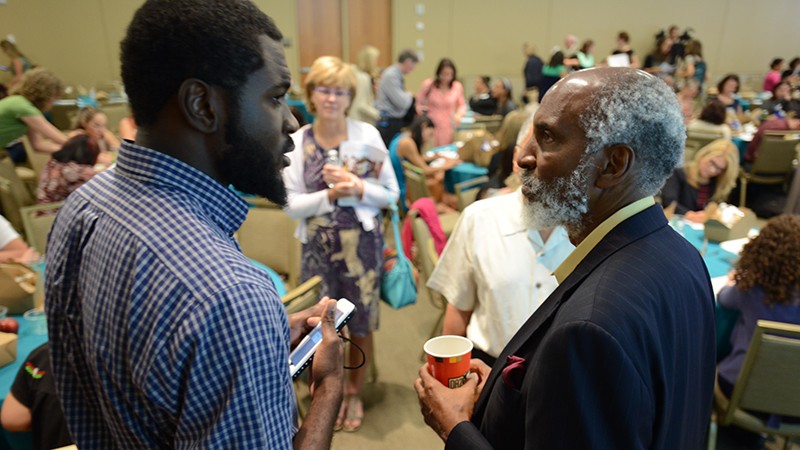Race and Health in America

Professor john a. powell, executive director of the Haas Institute for a Fair and Inclusive Society at University of California, Berkeley. Photo by David Cornwell
By Ned Calonge, MD, MPH
“Race is a lot like gravity,” said Berkeley professor john a. powell to a packed auditorium in Denver earlier this month. “All of us have weight. And yet, by some accounts, there are about 12 people in the world that really understand gravity. Maybe 14 people understand race.”
Like gravity, race exerts a pull whether or not we acknowledge its presence. But ignoring it can have painful consequences.
In the past year, the Black Lives Matter movement has brought racial injustice in law enforcement to the forefront of public discussion. The start of the 2016 presidential campaign has re-ignited a (sometimes toxic) debate over the worth of immigrants in our country. And a few days before powell spoke, a 14-year-old Texan named Ahmed Mohamed made news after he was arrested for bringing what turned out to be a homemade clock to school.
The fresh urgency of the national conversation demands an authentic and concerted effort at understanding.
As a professor of law, African American studies and ethnic studies at the University of California, Berkeley, and as executive director of the school’s Haas Institute for a Fair and Inclusive Society, powell has long been engaged with the study of race.
The Colorado Trust invited him to speak in our Health Equity Learning Series this month because he is certainly one of the few people who understands, and can describe, how the structures of race in our country work to harm the health of communities of color—and what to do about it.
To powell, the social determinants of health can be boiled down to one thing: Belonging. Whether a child has access to high-quality education, how far an employee has to travel to get to work, whether somebody makes enough money to survive, and whether a culture and language are celebrated or marginalized—these are markers that separate those who belong from the others.
“We all live in structures, and these structures are not neutral,” powell said.
Our physical and social environments distribute opportunity unevenly across the population. powell noted, for example, that poor blacks and Latinos are more likely than poor whites to live in areas of concentrated poverty. “These structures live in us,” powell added: the experience of living in a poor neighborhood affects brain development, lowering IQ scores and raising the load of toxic stress.
While race and socio-economic factors overlap, they’re not the same, said powell: “The stress of being black in America is independent of income.”
Black Lives Matter has focused on the police shootings and assaults that have claimed the lives of a disproportionate number of young black men—Michael Brown, Eric Garner and Freddie Gray among them. The harm from these shootings isn’t isolated to the people killed, powell said. They influence every interaction between blacks and the police, ratcheting up the stress of even a routine encounter.
When his own teenage son asked for a cell phone, powell refused to allow it. His reasoning? Being black raises the likelihood that police may mistake your cell phone for a gun.
The burden of being black in America begins even before children are born; powell pointed to research on black infant mortality and low birth-weight. College-educated black women are more likely to have premature babies than white women who don’t finish high school, he said, indicating that the stress of racialization can affect black women across income and education levels.
So what should we do about it? powell proposed that to achieve health equity in America, it isn’t enough to narrow disparities. And efforts to tackle internalized personal biases may be doomed when racialized structures remain intact.
Instead, he urged a goal of what he called “targeted universalism.” What this means, said powell, is a focus on helping everyone to achieve a universal outcome of good health. This goal requires us to acknowledge that people are differently situated—black life expectancy remains well below white life expectancy, for instance—so solutions have to be targeted differently to each group.
That’s a different approach than the traditional aim of treating everyone equally. If we start in different places and with different advantages, it isn’t enough to offer everyone the same path; powell’s analogy was that an escalator to the top wasn’t designed and won’t work for a person in a wheelchair.
powell called himself not an optimist or a pessimist, but a “possibilist.” Quoting poet Wendell Berry, he concluded: “Health is membership.” Our challenge is to recruit all people as members to a community of good health.
powell’s presentation has been viewed in listening parties across Colorado as part of The Trust’s Health Equity Learning Series. His entire speech is available here. We look forward to having you join us at next year’s Health Equity Learning Series events.